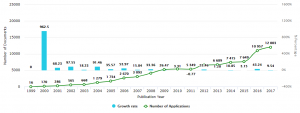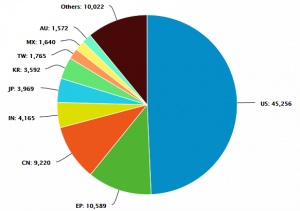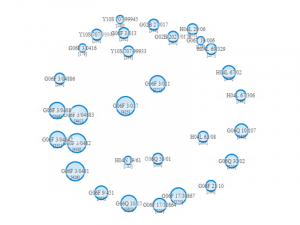 Microsoft is known for its large patent portfolio and aggressive patent strategy. The software giant invests more than $11.4 billion in research and development and owns a patent portfolio of over 90,000 currently active published patent applications. In this post, we analyze Microsoft’s patent assets, paying special attention to the high value patents in its portfolio.
Microsoft is known for its large patent portfolio and aggressive patent strategy. The software giant invests more than $11.4 billion in research and development and owns a patent portfolio of over 90,000 currently active published patent applications. In this post, we analyze Microsoft’s patent assets, paying special attention to the high value patents in its portfolio.
General patent trends
Figure 1 shows the year-wise growth in published patent applications for last 20 years. The patent applications show a steady upward trend, with an enhanced spurt post 2015. It is also seen that the number of published patent applications is highest in 2017.
Figure 2 depicts the key geographies where Microsoft files its patent applications. The European Union and China are the top jurisdictions after the United States.
High value patents in Microsoft’s portfolio
Using Relecura’s proprietary patent value metric, we derived an average Relecura Star rating of 2.42 out of 5 for Microsoft’s portfolio. The Relecura Star rating ranks each patent on a scale of five. It is a composite metric incorporating multiple criteria. The metric combines the different technology, business, and litigation related factors. Generally, a patent that scores three or more out of five in terms of the Star Rating is deemed as a “high value” patent.
We take a closer look at the high value patents within the portfolio. For this purpose, we refined the portfolio by limiting the Relecura Star rating to 3.0 or above. This gave us 14,070 currently active published patent applications for further analysis. The report lists the total number of published patent applications in each technology sub-category, along with the number of high value patents under them.
The maximum number of high value patents are seen under the technologies related to data processing, database management, wireless communication networks and speech synthesis.
Figure 3 indicates that there has been a slight decline in the number of published high value patents after 2014.
Figure 4 is a topic map of the CPC codes of the high value patents. In the figure, the size of a bubble corresponds to the total number of patent applications for a technology category. The bubble proximity corresponds to the similarity or “relatedness” of the individual technology categories.
Some of the top CPC codes covered by the high value patents include those related to user-interfaces and machine interaction such as G06F 3/04883 (touch-screen or digitiser for entering handwritten data), G06F 3/0482 (interaction with lists of selectable items, menus), G06F 3/0481 (interaction techniques based on displayed interaction object or a metaphor-based environment) and G06F 3/017 (hand gesture-based interaction).
Microsoft acquisitions have contributed to its pool of high value patents
From cloud computing to open innovation, Microsoft’s patent strategy has been evolving with the changing technology landscape.
It is observed that patent acquisitions have contributed to Microsoft’s pool of high value patents.
The report details the number and technology categories of the high value patents that Microsoft acquired either through M&A or transactions with other companies.
LinkedIn was Microsoft’s largest acquisition. LinkedIn is a social media website specializing in business relationships and professional networking. Microsoft acquired LinkedIn in 2016 for $26.2 billion. The report details the categories of the high value patents that were added to Microsoft’s patent portfolio with the deal, along with other acquisitions of high value patents.
The impact of Open Source on Microsoft’s patent strategy
Microsoft recently opened over 60,000 patents to the Open Invention Network (OIN) members. Microsoft joined the Open Invention Network, an open-source patent group designed to protect Linux from patent lawsuits, in October this year. The announcement on Microsoft blog states:
“We know Microsoft’s decision to join OIN may be viewed as surprising to some; it is no secret that there has been friction in the past between Microsoft and the open source community over the issue of patents. For others who have followed our evolution, we hope this announcement will be viewed as the next logical step for a company that is listening to customers and developers and is firmly committed to Linux and other open source programs.”
Microsoft earns huge royalties from licensing its patents. This move opens Microsoft’s entire patent portfolio covering the Linux System to OIN licensees. In the longer term, it would be interesting to see how Microsoft balances its open source initiatives with filing for patent protection for its own technologies and inventions.













